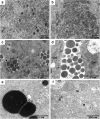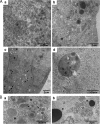Human cytomegalovirus UL97 kinase and nonkinase functions mediate viral cytoplasmic secondary envelopment
- PMID: 21248036
- PMCID: PMC3067882
- DOI: 10.1128/JVI.01952-10
Human cytomegalovirus UL97 kinase and nonkinase functions mediate viral cytoplasmic secondary envelopment
Abstract
Previous studies have revealed critical roles for the human cytomegalovirus (HCMV) UL97 kinase in viral nuclear maturation events. We have shown recently that UL97 affects the morphology of the viral cytoplasmic assembly compartment (AC) (M. Azzeh, A. Honigman, A. Taraboulos, A. Rouvinski, and D. G. Wolf, Virology 354:69-79, 2006). Here, we employed a comprehensive ultrastructural analysis to dissect the impact of UL97 on cytoplasmic steps of HCMV assembly. Using UL97 deletion (ΔUL97) and kinase-null (K355M) mutants, as well as the UL97 kinase inhibitor NGIC-I, we demonstrated that the loss of UL97 kinase activity resulted in a unique combination of cytoplasmic features: (i) the formation of pp65-rich aberrant cytoplasmic tegument aggregates, (ii) distorted intracytoplasmic membranes, which replaced the normal architecture of the AC, and (iv) a paucity of cytoplasmic tegumented capsids and dense bodies (DBs). We further showed that these abnormal assembly intermediates did not result from impaired nuclear capsid maturation and egress per se by using 2-bromo-5,6-dichloro-1-(β-d-ribofuranosyl) benzimidizole (BDCRB) to induce the artificial inhibition of nuclear maturation and the nucleocytoplasmic translocation of capsids. The specific abrogation of UL97 kinase activity under low-multiplicity-of-infection conditions resulted in the improved release of extracellular virus compared to that of ΔUL97, despite similar rates of viral DNA accumulation and similar effects on nuclear capsid maturation and egress. The only ultrastructural correlate of the growth difference was a higher number of cytoplasmic DBs, tegumented capsids, and clustered viral particles observed upon the specific abrogation of UL97 kinase activity compared to that of ΔUL97. These combined findings reveal a novel role for UL97 in HCMV cytoplasmic secondary envelopment steps, with a further distinction of kinase-mediated function in the formation of the virus-induced AC and a nonkinase function enhancing the efficacy of viral tegumentation and release.
Figures





Similar articles
-
The ULb' region of the human cytomegalovirus genome confers an increased requirement for the viral protein kinase UL97.J Virol. 2013 Jun;87(11):6359-76. doi: 10.1128/JVI.03477-12. Epub 2013 Mar 27. J Virol. 2013. PMID: 23536674 Free PMC article.
-
Structural changes in human cytomegalovirus cytoplasmic assembly sites in the absence of UL97 kinase activity.Virology. 2006 Oct 10;354(1):69-79. doi: 10.1016/j.virol.2006.05.037. Epub 2006 Jul 26. Virology. 2006. PMID: 16872656
-
Comparison of effects of inhibitors of viral and cellular protein kinases on human cytomegalovirus disruption of nuclear lamina and nuclear egress.J Virol. 2014 Sep;88(18):10982-5. doi: 10.1128/JVI.01391-14. Epub 2014 Jun 25. J Virol. 2014. PMID: 24965476 Free PMC article.
-
Function of human cytomegalovirus UL97 kinase in viral infection and its inhibition by maribavir.Rev Med Virol. 2009 Jul;19(4):215-29. doi: 10.1002/rmv.615. Rev Med Virol. 2009. PMID: 19434630 Free PMC article. Review.
-
[Structure and assembly of human beta herpesviruses].Nihon Rinsho. 1998 Jan;56(1):22-8. Nihon Rinsho. 1998. PMID: 9465660 Review. Japanese.
Cited by
-
Discovery of a Coregulatory Interaction between Kaposi's Sarcoma-Associated Herpesvirus ORF45 and the Viral Protein Kinase ORF36.J Virol. 2016 Jun 10;90(13):5953-5964. doi: 10.1128/JVI.00516-16. Print 2016 Jul 1. J Virol. 2016. PMID: 27099309 Free PMC article.
-
Antagonistic Relationship between Human Cytomegalovirus pUL27 and pUL97 Activities during Infection.J Virol. 2015 Oct;89(20):10230-46. doi: 10.1128/JVI.00986-15. Epub 2015 Jul 29. J Virol. 2015. PMID: 26223645 Free PMC article.
-
Role of human cytomegalovirus tegument proteins in virion assembly.Viruses. 2014 Feb 6;6(2):582-605. doi: 10.3390/v6020582. Viruses. 2014. PMID: 24509811 Free PMC article. Review.
-
Antagonistic determinants controlling replicative and latent states of human cytomegalovirus infection.J Virol. 2014 Jun;88(11):5987-6002. doi: 10.1128/JVI.03506-13. Epub 2014 Mar 12. J Virol. 2014. PMID: 24623432 Free PMC article.
-
The ULb' region of the human cytomegalovirus genome confers an increased requirement for the viral protein kinase UL97.J Virol. 2013 Jun;87(11):6359-76. doi: 10.1128/JVI.03477-12. Epub 2013 Mar 27. J Virol. 2013. PMID: 23536674 Free PMC article.
References
-
- Azzeh, M., A. Honigman, A. Taraboulos, A. Rouvinski, and D. G. Wolf. 2006. Structural changes in human cytomegalovirus cytoplasmic assembly sites in the absence of UL97 kinase activity. Virology 354:69-79. - PubMed
-
- Baek, M. C., P. M. Krosky, Z. He, and D. M. Coen. 2002. Specific phosphorylation of exogenous protein and peptide substrates by the human cytomegalovirus UL97 protein kinase. Importance of the P+5 position. J. Biol. Chem. 277:29593-29599. - PubMed
-
- Baek, M. C., P. M. Krosky, A. Pearson, and D. M. Coen. 2004. Phosphorylation of the RNA polymerase II carboxyl-terminal domain in human cytomegalovirus-infected cells and in vitro by the viral UL97 protein kinase. Virology 324:184-193. - PubMed
Publication types
MeSH terms
Substances
Grants and funding
LinkOut - more resources
Full Text Sources

